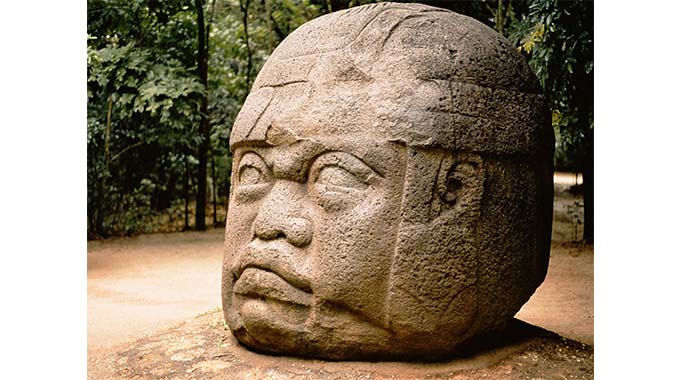Writing Covid-19: On the arts, flowers, astronomy and the origins of people

Pathisa Nyathi
It’s 0300, the most ungodly of hours. My mind is sufficiently rested to venture into the recesses of the universe for exploration. I have written down the following words: “There is universal reality and symbolisation of sexuality.” The fuel that lifted my mind into the orbit of mental exploration was provided by what I had been reading.
A black people called the Olmec sailed from Africa and ultimately landed in Meso-America long before the birth of Christ and the travels to America by Christopher Columbus. The said people made colossal stone heads with distinctive Negroid features, a typically large and flat nose and thick lips. Hmm… so after all!
What led to my reading about the history of the black man in the Americas was the common cosmology regarding a stellar constellation known as Pleiades which is a small cluster of seven stars which have oral traditions among many societies. The African people equally attach some significance to the stars which in IsiNdebele are known as isilimela.
These particular stars are markers of time and seasons when rains are approaching and agriculturalists start preparing to cultivate their lands. Those who were undergoing initiation, the rites of passage, graduate at the time.
The world of science has in the past been ignoring African American scholars such as Ivan Van Sertima regarding the reality of a Negroid people settling in the Americas long before the emergence of Mayan and Aztec civilizations with their pyramid construction inherited from the Olmecs who migrated from Africa.
These later arrivals used pyramids for bloodletting and human sacrifice, something the Olmecs did not do. It is science that now acknowledges that Negroid peoples who were the first inhabitants of the Americas were descended from the Australian Aborigines. A Dr Walter Neves has been doing some research along these lines.
The Olmecs are linked to the Mandinga who used Mende to write and speak the Mende language. Interestingly, as we have always maintained, Art in its various genres and manifestations is a veritable archive of a people’s history, identity and origins. Art is expressive culture. The Olmecs executed art forms that were reminiscent of those in West Africa and to a lesser extent those in Central and Southern Africa.
On their clay and terracotta statuettes and busts Olmecs produced representations of ear plugs, scarification marks(incisions) on the skin and face, cornrows (a hairstyle very common among women even here in Zimbabwe, representing the arrangement of grains on the maize cob) and dreads. These are distinctly African artistic expressions executed within the context of sculpture.
Back to the source of the argument. Of late authors have been drawing similarities between the Greek myths and indigenous Australian Aborigines. Their stories regarding Pleiades are similar.
The question is how is this possible for peoples who live so far apart? In most cultures the seven stars in the Pleiades are referred to as the “Seven Sisters,” or “Seven Little Girls,” or “Seven Maidens,” in the constellation Taurus. The story of the “Seven Girls” was told a 100 000 years ago by African ancestors. What has been contentious is how seemingly different people in the world came up with the same story regarding the stars, which number over 800 but only 7 of them are visible to the naked eye while the rest are picked by means of a telescope.
Not very far from these stars are two stars, Atlas and Pleione. As a result of the earth’s rotation, another star, Orion, is cast as a hunter in the traditions and seems to be chasing after Isilimela. Now we are close to the issue that some are ridiculing. What is common in many societies is that the sky is fraught with male and female stars/figures. Orion is featured as masculine while Pleiades in presented as female.
Why? This should not come as a surprise at all if African Thought is applied. One critic of the idea is Bradley Schafer of Louisiana State University. He says, “Humans are humans they will populate the sky with male and female figures. By chance alone, about half the time you would expect to give constellations to be constituted with men and half the time by with women which means that about a quarter of the time Orion will be masculine and the Pleiades will be female.”
If Schafer did seek to get into the minds of Africans and indeed that of all ancients he would have known about ideas and perceptions regarding sexuality. It’s back to what I wrote at the beginning of this article: “There is universal reality and symbolisation of sexuality.”
In the Sunday News column, I did indicate that a phallus executed in chalk was retrieved during excavations at Stonehenge. The phallus was equipped with two testes. At Great Zimbabwe we find the same phallus passing as the Conical Tower with two stone testes.
I have on several occasions given the famous African adage, “As above, so below.” What is encapsulated there is the fact that Africans, to be understood as ancestors of all humanity in the world sought to replicate the heavens on earth, that is on the cultural front. What they perceived in the heavens is thus what they replicated.
Among several other observations they made was to see male and female figures in the heavens. There was no mistake in them seeing male and female characters. They perceived the stars as countless, numerous and displaying eternity, endlessness and perpetuity in terms of their lives.
That was achieved through one process that they observed and, in their case and that of other animal species on earth, was sexuality. If that is the biological process of multiplication on earth, surely it must also be the process in heaven. So, they sought to replicate it within the cultural front on earth.
A ruling lineage sought to extend and ensure its lineage endured. The human species should to endure. The community too ought to endure. Symbolisation of sexuality came into being to guarantee the much sought-after traits of continuity, eternity, endlessness and perpetuity, after seeing what it achieves on the human front. My coining of the expression, “Individuals perish, humanity is forever,” aptly expresses and encapsulates that idea. After a long and circuitous route, we get to the gist of this article which in essence is about Covid-19.
Not so long ago in South Africa it was a critical shortage of flowers. It was a shortage which included that of coffins. My interest is in flowers which have made it in parts of Africa to burials and expressions of love and sympathy. Apparently, flowers have been adopted in recent times. Looking at the florists outside City Hall in Bulawayo points to the expanding business in flowers. Coronavirus in South Africa, where a new variant has been detected the number of deaths is spiking.
Burials have recently been associated with flowers, an expression of sexuality. I did mention flowers alongside geometric designs when women from Matobo execute face painting. Flowers have recently been incorporated into the decorative designs, Flowers are appreciated on the grounds of their designs, irresistible aroma and captivating colours. It has to be appreciated that flowers are in essence sexual organs of plants. It is through flowers that plants multiply their numbers and ensure their eternity and endlessness.
Covid-19 is thus a negation of what flowers express and symbolise as sexual organs of plants. It is all about increase in population and operationalising eternity, continuity, endlessness and perpetuity of the plant species. This is what the heavens with their stars depict. This is the basis for the creation of masculine and female figures in the stellar world-the heavens. Were it not so, the stars would not be that innumerable and have endured this long-billions of years. Perceptions, perceptions and ideas and beliefs cont for that much.
Interestingly, what I said about Stonehenge is what researchers are speculating regarding what transpired. They concluded, “In other words our ancestors who had not yet left Africa first came up with the tales and then carried stories about the night sky as they migrated to Europe across Asia and eventually to Australia.
In the ancient world a search for the evidence of ideas that were brought out of Africa lies in the art in its various genres and manifestations, Astronomy (knowledge, ideas and perceptions concerning the heavens) and representations and symbolisation of their spirituality.
When these considerations are taken on board, the African and his pre-Columbian ideas will be found in the areas where migration from Africa ended. This was precisely the reason I got interested in Stonehenge. What ideas, beliefs and myths did people migrating out of Africa about 100 000 years ago take with them?
The African legacy wherever it manifests itself should be identifiable even where it has been supplanted and subsumed by cultures of people who arrived after them such as the Indians in the Americas and both the Mayas and Aztecs. As long as Africa is regarded to be the cradle of humankind, her legacies lie not only on the African continent, but indeed in the rest of the world where her children went to.









Comments